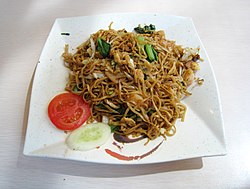Mie goreng: Difference between revisions
m r2.7.3) (Robot: Adding th:หมี่โกเร็ง |
No edit summary |
||
| Line 15: | Line 15: | ||
}} |
}} |
||
'''Mie goreng''' ({{lang-id|mie goreng or mi goreng}}; {{lang-ms|mee goreng or mi goreng}}; both meaning "fried noodles"<ref>{{cite news | first= Bill | last= Guerin | title= World's top noodle maker loses its bite | url= http://www.atimes.com/atimes/Southeast_Asia/EL23Ae04.html | publisher= [[Asia Times Online]] | date=2003-12-23 | accessdate=2007-08-22 }}</ref>) is a dish common in [[Indonesia]], [[Malaysia]], and [[Singapore]]. It is made with thin yellow [[noodle]]s fried in [[cooking oil]] with [[garlic]], [[onion]] or [[shallot]]s, fried [[prawn]], [[chicken (food)|chicken]], or [[beef]], sliced [[bakso]] (meatballs), chili, [[Chinese cabbage]], [[cabbages]], [[tomatoes]], [[egg (food)|egg]], and [[acar]] ([[Pickling|pickles]]). Ubiquitous in Indonesia, it can be found everywhere in the country, sold by all food vendors from street-hawkers to high-end restaurants. Mie goreng is Indonesian one-dish meal favorite, at the street food hawkers mie goreng is very common to be sold together with [[nasi goreng]] (fried rice).<ref>{{cite web |url=http://wokwithray.net/wwr/2012/03/mie-goreng-by-indonesia-eats/ |title=Friend’s Post – Mie Goreng by Indonesia Eats |author=Pepy Nasution |date=7 March 2012 |work= |publisher=Wok With Ray |accessdate=3 June 2012}}</ref> It is commonly available at [[mamak stall]]s in Singapore and Malaysia and is often spicy. |
'''Mie goreng''' ({{lang-id|mie goreng or mi goreng}}; {{lang-ms|mee goreng or mi goreng}}; both meaning "fried noodles"<ref>{{cite news | first= Bill | last= Guerin | title= World's top noodle maker loses its bite | url= http://www.atimes.com/atimes/Southeast_Asia/EL23Ae04.html | publisher= [[Asia Times Online]] | date=2003-12-23 | accessdate=2007-08-22 }}</ref>) also known as '''bami goreng''' is a dish common in [[Indonesia]], [[Malaysia]], and [[Singapore]]. It is made with thin yellow [[noodle]]s fried in [[cooking oil]] with [[garlic]], [[onion]] or [[shallot]]s, fried [[prawn]], [[chicken (food)|chicken]], or [[beef]], sliced [[bakso]] (meatballs), chili, [[Chinese cabbage]], [[cabbages]], [[tomatoes]], [[egg (food)|egg]], and [[acar]] ([[Pickling|pickles]]). Ubiquitous in Indonesia, it can be found everywhere in the country, sold by all food vendors from street-hawkers to high-end restaurants. Mie goreng is Indonesian one-dish meal favorite, at the street food hawkers mie goreng is very common to be sold together with [[nasi goreng]] (fried rice).<ref>{{cite web |url=http://wokwithray.net/wwr/2012/03/mie-goreng-by-indonesia-eats/ |title=Friend’s Post – Mie Goreng by Indonesia Eats |author=Pepy Nasution |date=7 March 2012 |work= |publisher=Wok With Ray |accessdate=3 June 2012}}</ref> It is commonly available at [[mamak stall]]s in Singapore and Malaysia and is often spicy. |
||
==Origin and variations== |
==Origin and variations== |
||
Revision as of 18:14, 3 September 2012
 Mie goreng in a restaurant in Jakarta. | |
| Alternative names | Mee goreng or Mi goreng |
|---|---|
| Course | Main course |
| Place of origin | Indonesia, Malaysia, Singapore |
| Region or state | Nationwide |
| Created by | Chinese Indonesian and Peranakan |
| Serving temperature | Hot |
| Main ingredients | Fried noodles with chicken, meat or prawn |
Mie goreng (Indonesian: mie goreng or mi goreng; Malay: mee goreng or mi goreng; both meaning "fried noodles"[1]) also known as bami goreng is a dish common in Indonesia, Malaysia, and Singapore. It is made with thin yellow noodles fried in cooking oil with garlic, onion or shallots, fried prawn, chicken, or beef, sliced bakso (meatballs), chili, Chinese cabbage, cabbages, tomatoes, egg, and acar (pickles). Ubiquitous in Indonesia, it can be found everywhere in the country, sold by all food vendors from street-hawkers to high-end restaurants. Mie goreng is Indonesian one-dish meal favorite, at the street food hawkers mie goreng is very common to be sold together with nasi goreng (fried rice).[2] It is commonly available at mamak stalls in Singapore and Malaysia and is often spicy.
Origin and variations
The dish is derived from Chinese chow mein and believed to have been introduced by Chinese immigrants in Indonesia, Malaysia, and Singapore. Mie goreng is also similar to Japanese yakisoba. However mie goreng has been more heavily integrated into Indonesian cuisine; for example the application of popular sweet soy sauce, spinkle of fried shallots, addition of spicy sambal and the absence of pork and lard in favour for shrimp, chicken, or beef; to cater for the Muslim majority.
In Indonesia mie goreng variants usually named after the ingredients, for example common mie goreng usually uses chicken, but mie goreng sapi uses beef, mie goreng kambing uses goat meat or mutton, mie goreng udang uses shrimp while mie goreng seafood uses mixture of fish, squid and shrimp. Some mie goreng might be named after the region of origin, such as Mie Goreng Aceh from Aceh province, mie goreng Jawa from Central Java and mie goreng Surabaya from Surabaya city. Mie goreng tek-tek refer to mie goreng sold by travelling street hawkers that hitting the wok making "tek-tek" sounds to announce their wares, while mie goreng dhog-dhog refer to mie goreng Surabaya that uses slit drum instead.[3] Indonesian tends to named similar foreign dishes as mie goreng, for example in Indonesia, chow mein is often called mie goreng China and yakisoba is called mie goreng Jepang. The instant version of mie goreng, Indomie Mi goreng, is also popular in Indonesia and other countries, notably Netherlands, Nigeria, Australia, and New Zealand.
Gallery
-
Basic mie goreng tek-tek sold by travelling street vendor
-
Mie goreng with chicken and shrimp in Jakarta
-
Mie goreng served as part of hotel breakfast buffet
-
Mie goreng Aceh
-
Mie goreng and nasi goreng combo, a hotel breakfast buffet
References
- ^ Guerin, Bill (2003-12-23). "World's top noodle maker loses its bite". Asia Times Online. Retrieved 2007-08-22.
- ^ Pepy Nasution (7 March 2012). "Friend's Post – Mie Goreng by Indonesia Eats". Wok With Ray. Retrieved 3 June 2012.
- ^ Rinny Ermiyanti Yasin (1 February 2012). "Diferensiasi: Antara Tek-tek dengan Dhog-dhog" (in Indonesian). Kompasiana. Retrieved 3 June 2012.
External links
- Indonesian Mie Goreng Recipe
- Mie Goreng (Indonesian Fried Noodle) Recipe
- Mee Goreng Recipe
- Mi Goreng Jawa recipe (in Indonesian)
- Mie Goreng Ayam cooking instructions (from youtube)





